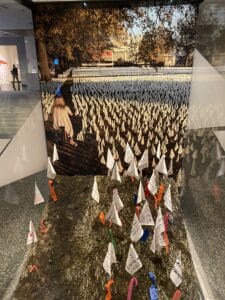In late October, the former hospital in Krakow located in Kopernika Street was transformed into a performative museum for some period of time. One of the exhibitions was entitled Pilot 9/11. The description of the showroom stated that it offers a fresh perspective on the events of 9/11.
On Sunday, October 21st, some bystanders who had bought the tickets for the exhibition were waiting in the hallway to enter the show-room. Whilst waiting, they could observe a person in the showroom. When it was their turn – they put on glasses and were immersed in the middle of the performance entitled Pilot of 9/11.
The performance lasts 20 minutes during which you are placed in the flight deck as the captain of the plane. It seems incredibly real. In front of the plane you are sitting in, there is another plane. You see how the machine is approaching the Twin Towers. You are surrounded by buttons you can press, but you cannot stop the events. You know that in a few seconds, it will crush into the Tower. And indeed – that is what was happening a few seconds later. Then you see clouds of dust.
The question is: Who in this computer-generated environment is the subject of the story? Is it the one who watches or maybe the one who tells the story? In this case, is the subject the traumatized pilot of the plane who was the witness of the crash of 9/11?
Everyone knows the story. It was a media event. Everyone also had a storyto tell on 9/11 – where they were, and who they lost. The stories of traumatized bystanders of the 9/11, survivors, and their families are being collected all the time. The trend of collecting tears from ordinary citizens started in the 80’s. It is known as a memory boom. Thanks to the trend –
memories of victims and witnesses gained a place in culture and in politics as well as in science. Nothing new – one may say. Ars memorabilia has been very popular since ancient times. It is a fact, but memory has never gained its place in science. Since the boom researchers on memories, such as Maurice Halbwachs started to become popular. It was when Pierre Nora introduced the term memory places.
Thanks to memory boom the 80’s in Europe and the USA saw the rise of museums and memorials. Most of them aimed to translate past memories to present people. They started to become narrative museums. One of the first places that did this – was the United States Holocaust Memorial Museum (USHMM). These new types of museums stopped serving only as places that exhibit objects. Instead, they started to tell stories that people could understand. Since the 80s, the role of museums visitors also started to change. They were not passive viewers anymore. They started to engage with the exhibitions.
This is what happened in the display Pilot 9/11. Its author, Polish artist and designer Norman Leto (his real name is Łukasz Banach) transferred American trauma to Polish viewers. For a few minutes, Polish viewers took the role of American witnesses of 9/11. Maybe many Polish citizens are not able to fully understand the trauma of American witnesses – as they were not raised in American democracy, but thanks to VR and thanks to Leto they can fully understand the weakness and powerlessness felt by American witnesses in the face of the event.
We know that taking on the role of witness is not new, and American culture pioneered popularizing it for democratic purposes. But the exhibition is still important as it also raises new questions about the cultural dimensions of memory. The questions are not only on how new technologies can impact our practices of visiting museums but – on how they can affect our practices of remembrance. The last question is: How do artistic practices nowadays perform the past in the present and what is their relationship to the archive?
Dziękuję organizaotrom za możliwość zwiedzenia wystawy. Więcej/More: https://patchlab.pl/program/wystawa/. Dziękuję D. W. za drobną korektę.


